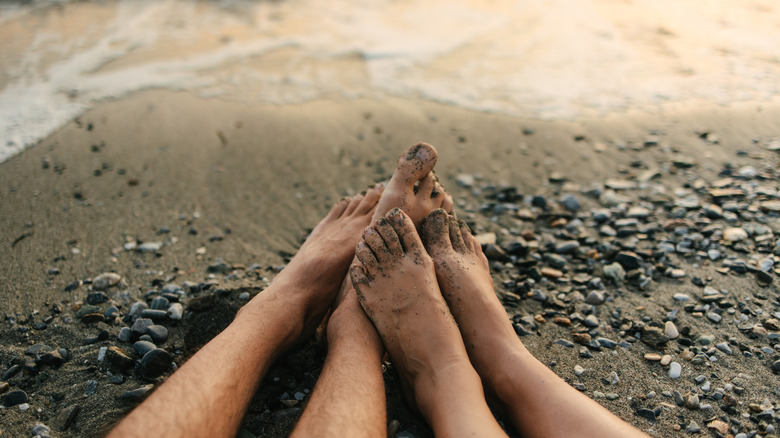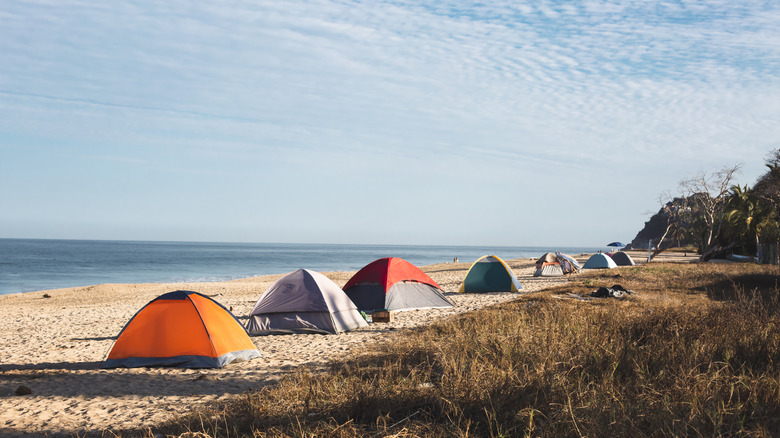Easy Steps To Take While Beach Camping To Avoid Sand Annoyances
Camping right on the beach gives you access to some of the most spectacular scenery you'll find outdoors. From endless ocean views to stunning sunsets that paint the sky in brilliant colors, choosing a destination where you can go camping on the beach means you'll always wake up to some pretty incredible views right outside your tent door. However, anyone who's spent a night sleeping near the shoreline knows that getting coated in sand comes with the territory. And let's be honest: This fine-grained companion has a way of infiltrating pretty much every corner of your campsite — from your sleeping bag and food to your camera gear and clothing.
Whether you're planning a beach camping trip in Europe or setting up camp stateside at a gorgeous state park, the reality is that sand's going to become part of your beach camping experience whether you like it or not. However, that doesn't mean that you have to let it completely take over your trip. In fact, with some simple preparation and a few strategic steps, you can significantly reduce the amount of sand that ends up in your tent, RV, or gear.
Put simply, the key lies in creating barriers and establishing routines that keep sand where it belongs — on the beach rather than in your living space. Better yet, managing sand effectively doesn't even require any expensive equipment or complicated systems. Instead, it's all about taking a common-sense approach with readily available supplies — an easy approach that can make the difference between a gritty, uncomfortable trip and an enjoyable beach camping experience that you'll want to repeat.
Create barriers to keep sand out of your space
One of the most effective ways to manage sand is to stop it before it gets into your tent or RV. To do that, start by placing a small tarp or outdoor mat directly in front of the entrance. This designated clean-up zone will give you and your camping companions a specific area to brush off your feet and gear before walking into your sleeping space. Ideally, you'll want to choose a tarp that's large enough for people to comfortably stand on while removing shoes or shaking out clothing.
Along with that, experienced campers also recommend setting up a simple foot-washing station next to your entrance barrier. A basic plastic tub filled with fresh water works perfectly for this purpose, just make sure you keep a dedicated towel nearby so that you can dry your feet before walking inside. You can even enhance this little cleaning station by keeping a small amount of baby powder handy to help remove stubborn, wet sand that clings to skin.
Lastly, if you've got enough room, pack a small broom and dustpan that you use specifically for beach camping trips. Even with the best prevention methods, some sand will inevitably find its way inside your space — and a quick sweep each morning and evening will keep any stray sand from building up to uncomfortable levels.
More tips for a comfortable beach camping experience
Beyond managing sand infiltration, a successful beach camping trip also requires paying close attention to the environment around you. Before setting up your tent, take some time to smooth out the sand in your chosen sleeping area. This, because even though sand might look soft and comfortable, any lumps and uneven spots can create uncomfortable pressure points that'll make for a miserable night's sleep. To do this, just use your hands or feet to level out the ground, and remove any stray shells, rocks, or debris.
In terms of weather protection, make sure you always keep your tent's rain fly attached — even when the weather seems perfect — unless you want to deal with sand and salt coating everything inside. After all, coastal winds can carry sand and salt spray, and removing your fly for even a short period of time can result in everything inside your tent getting coated in grit. Plus, beach weather can also change dramatically throughout the day, with scorching hot afternoons giving way to surprisingly cool nights, which means your tent's protection becomes even more important as conditions shift.
Most importantly, you'll always want to pay close attention to tide schedules before choosing your spot. Look around for telltale signs of where the water reached during the last high tide — things like lines of seaweed, shells, or other debris scattered across the sand — and make sure to set up your camp well beyond that point. Additionally, you can also check tide charts ahead of your trip to understand when high and low tides will occur during your stay — a simple step that can prevent you from waking up to find water lapping at your tent door or your gear floating away with the incoming waves.


